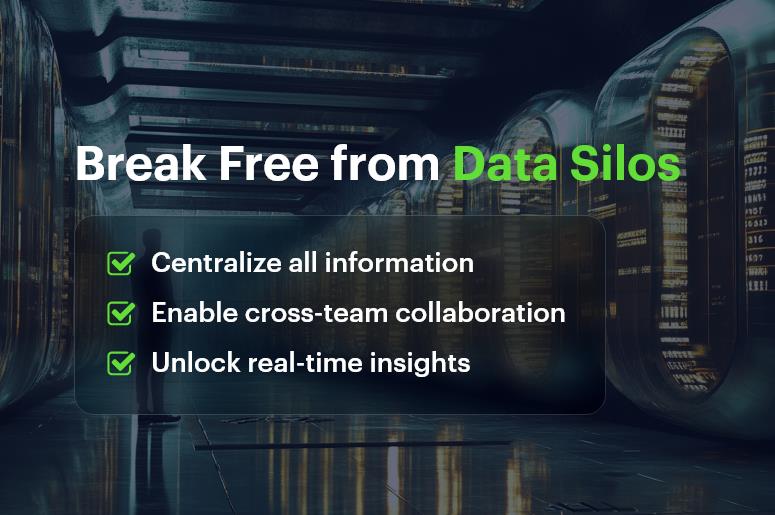In today’s competitive, fast-moving business environment, data silos are quietly sabotaging your productivity. According to Gartner, poor data quality — including siloed data — costs organizations an average of $12.9 million per year. It’s not just about lost revenue; it’s about missed opportunities, duplicated work, and frustrated teams.
Data silos are what happen when different departments hoard information in disconnected systems. Sales uses one tool. HR uses another. Finance has a spreadsheet. Nobody talks, and nothing flows. The result? Poor communication, inconsistent data, and a sluggish, inefficient workflow.
But it doesn’t have to be this way.
This guide will show you how data silos are hurting your business—and more importantly, how to break them down using modern CRM software. By the end, you’ll have clear strategies and tools to eliminate information barriers and unlock real productivity.

Why Data Silos Are a Problem for Growing Businesses
If you’re scaling a team or expanding across departments, data silos become a ticking time bomb. At first, they’re subtle — some missed emails here, a delayed response there. But as your team grows, the cracks widen.
Here’s why data silos are such a problem:
- They slow decision-making. When teams don’t have access to the same information, decisions are made with outdated or incomplete data.
- They breed inefficiency. Multiple versions of the same data create confusion, extra work, and duplicated efforts.
- They block collaboration. Cross-functional teams can’t align when data lives in different places.
- They damage customer experience. If support doesn’t know what sales promised, or billing isn’t aligned with service delivery, the customer suffers.
Industry Examples
- Retail: Sales and inventory operate in silos, leading to stockouts or overordering.
- Healthcare: Patient data is locked in separate systems across departments, delaying treatment.
- Manufacturing: Supply chain, procurement, and finance use disconnected tools, leading to budget overruns and delays.
In short, data silos aren’t just annoying — they’re costly and risky.
How to Break Down Data Silos: Best Practices That Work
You don’t need to overhaul your entire business to eliminate data silos. Small, strategic steps can have a massive impact — especially when powered by an integrated CRM platform like CRMLeaf.
1. Centralize Your Data
Start by bringing all critical data — customer, project, HR, sales, finance — into one unified system. This ensures that everyone sees the same real-time information.
Quick Tip: Use CRM software that supports multi-departmental integration.
Why it matters: When teams access the same data, you reduce confusion and increase alignment.
2. Standardize Data Entry Across Teams
Inconsistent data entry is a silent killer. Standard fields, dropdowns, and input rules ensure that all departments collect and store data uniformly.
Quick Tip: Build standardized forms within your CRM system for every team — sales, support, HR, etc.
Why it matters: Standardization eliminates duplication and makes data easier to analyze.
3. Automate Workflows Between Departments
Automated triggers help hand off tasks between teams — like notifying finance when a sale is closed or alerting HR when a new hire is added.
Quick Tip: Use your CRM platform to automate recurring, cross-functional workflows.
Why it matters: This reduces manual back-and-forth and eliminates dropped handoffs.
4. Enable Role-Based Access for Transparency & Control
Everyone should see what they need — no more, no less. Role-based permissions help break silos while maintaining data security.
Quick Tip: Set permissions by department or role inside your CRM to maintain data privacy without hiding critical information.
Why it matters: Balanced transparency boosts collaboration without risking sensitive data.
5. Train Teams to Use One Source of Truth
Tool fatigue is real. If your teams are bouncing between 7 apps, they’ll default to what they know. Reinforce the CRM as the single source of truth.
Quick Tip: Offer onboarding and refresher training. Highlight how the CRM improves their daily workflow.
Why it matters: Adoption is key — technology doesn’t break silos, people do.
Customer Success Story: Breaking Silos in Real Time
SkyTech Solutions, a mid-sized IT services firm, struggled with disconnected tools across sales, service, and HR. Sales used spreadsheets. HR used outdated software. Communication was fragmented, and productivity dropped.
By switching to CRMLeaf, they centralized all client, employee, and project data in one place. Automated workflows linked sales to onboarding, while real-time dashboards gave leadership total visibility. In just 4 months, productivity increased by 28%, and internal support ticket resolution improved by 35%.
Here’s how:
- Unified CRM reduced manual follow-ups by 60%
- Role-based access ensured secure, department-specific visibility
- Automated alerts eliminated missed handoffs between teams
Key Takeaways
- Data silos block visibility, reduce efficiency, and hurt collaboration.
- Centralizing information through a unified CRM platform boosts productivity and communication.
- Breaking silos doesn’t require massive change — just smarter, integrated tools and consistent processes.
Data silos are a silent killer of productivity in growing businesses. They fragment information, delay decision-making, and weaken collaboration across departments. But with the right approach, you can eliminate these silos without overhauling your entire operation.
A unified CRM platform like CRMLeaf empowers teams to work from a single source of truth, enabling real-time access to critical data across departments.
By centralizing information, standardizing inputs, automating cross-functional workflows, and implementing role-based access, businesses can drastically improve operational efficiency. Ultimately, breaking down data silos leads to better collaboration, faster decisions, and a measurable boost in productivity.

